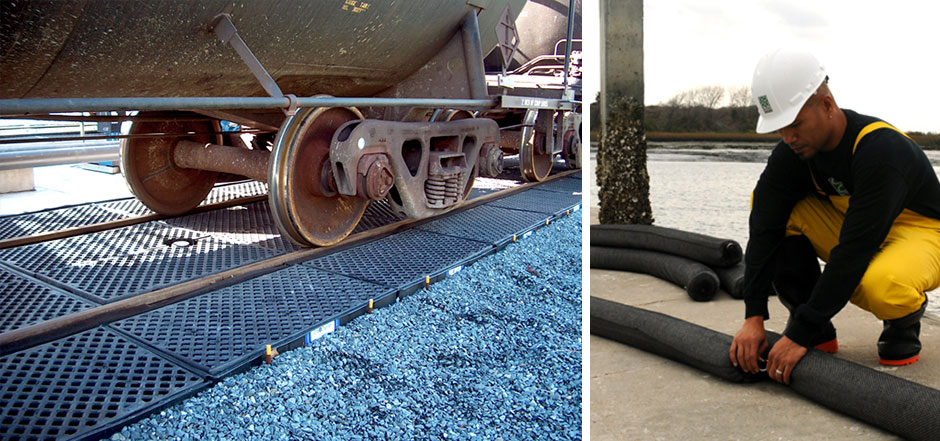Part 2 of SafeRack’s Spill Prevention and Containment Series. Always be ready with a full clean-up strategy and proper supplies and make sure to familiarize yourself with the types of sorbents that may be needed in these emergency situations.
The is a Second Part of a Two Part Series on Spill Prevention and Containment.
Part 1 – Is your facility prepared properly for Spill Containment ?
Being prepared for emergency spills is an important and necessary part of any company’s safety program. Nobody wants to have this happen, but having an action plan in place is key.
The Occupational Safety and Health Administration (OSHA) is applicable to five distinct groups of employers and their employees. These include any employees who are exposed or potentially exposed to hazardous substances – including hazardous waste – and who are engaged in one of the following operations*:
- Cleanup operations required by a governmental body, whether federal, state, local or other, involving hazardous substances that are conducted at uncontrolled hazardous waste sites
- Corrective actions involving cleanup operations at sites covered by the Resource Conservation and Recovery Act of 1976 (RCRA) as amended (42 U.S.C. 6901 et seq.)
- Voluntary cleanup operations at sites recognized by a federal, state, local, or other governmental body as uncontrolled hazardous waste sites
- Operations involving hazardous wastes that are conducted at treatment, storage and disposal facilities regulated by Title 40 Code of Federal Regulations Parts 264 and 265 pursuant to RCRA, or by agencies under agreement with U.S. Environmental Protection Agency to implement RCRA regulations
- Emergency response operations for releases of, or substantial threats of releases of, hazardous substances regardless of the location of the hazard
*Operations as specified by 1910.120(a)(1)(i-v) and 1926.65(a)(1)(i-v):
The key component here is the emergency response operations for the releases or potential releases of hazardous substances regardless of where the hazard occurred. A simple, but powerful response plan might look something like this:
- Remove all employees from the area where the spill occurred.
- Categorize what the hazardous material is.
- Immediately inform the emergency response crew.
- Block off the spill area, containing it where it happened, and let anyone in the facilities know to evacuate and avoid the hazardous area.
- If there is a chance of combustion, immediately notify the fire department and disconnect all sources of ignition.
- Put on and wear the appropriate protective gear.
- Ensure the spill has been confined.
- Clean up the hazardous spill.
- Get rid of the hazardous spill, following all regulations on the local, state, and federal levels.
While nobody wants something like this to happen to them or their company, it’s important to use spill mitigation and containment solutions on-site… and always important to be ready with an action-plan. Knowing what kind of spills might happen in your facilities will help you put together a full arsenal of powerful and appropriate tools including what sorbents are best to use to help absolve the emergency situation and the subsequent fines and environmental damage. SafeRack has safety experts that can assess your work environment. We also have spill containment solutions for any application to help mitigate spills before they happen. Whether it’s spill berms, drum spill containment, IBC spill containment, railcar spill containment, or truck spill containment, SafeRack has what you need and has a full team to support you in your emergency situation.
Take a look at the product range of spill containment tools that SafeRack has to offer
What are Sorbents?
Sorbents retain and pick up liquids with a mixture of materials through absorption, or adsorption, or both. Sorbents are often both oleophilic (oil-attracting) and hydrophobic (water-repellent).
Sorbent Forms
Booms, which are tools to contain and control spills, are cylindrical in shape and vary in length and width. In some instances, booms contain spills on water, and can be inter-connected together and ultimately used as a large spill barrier when positioned on water.
There are also socks or mini booms, which are also cylindrical and vary in length and width. Emergency response teams typically use these tools and they are also used in maintenance applications. Socks can be used to contain spills or can be placed around machinery or other equipment to contain leaks.
Pillows, which are rectangular in shape, are filled with sorbent media. Pillows are typically used to clean up medium-sized spills. They can be used to eliminate potential overflow situations or they can be proactively used to avoid spills when moving liquids.
Another form of sorbents are pads and sorbent rolls which are flat, sorbent sheets. They come in unperforated rolls, perforated rolls or custom manufactured to a specific size, up to 300 feet long. These pads can be used preemptively to line shelves or can be used to catch leaks under machinery and clean up spills.
Loose or particulate sorbents are composed of sorbent media that is not contained in any type of skin. Used mostly for small spills, the application of these loose sorbents depends on the type of sorbent media used.
Sorbent Categories
Sorbents range in forms, but the three main categories of sorbents are universal petroleum and maintenance. The materials which make up these categories vary, including synthetics, such as polypropylene; inorganic materials, such as expanded silicates and clay; and organic materials, such as cellulose and wood fibers.
Universal sorbents are designed to absorb any liquid. They will absorb forceful liquids, such as acids and bases as well as more passive liquids and solvents, such as cleaners, water-based fluids, gasoline, and alcohols. Universal sorbents are made of surfactant-treated polypropylene or expanded silicate materials.
Note: Polypropylene sorbents are the best sorbents to use when cleaning up a hydrofluoric acid spill, as universal sorbents made of expanded silicate will cause a heat reaction when mixing with the hydrofluoric acid.
Petroleum sorbents or “oil-only sorbents” are designed for the absorption of oil and/or petroleum-based liquids. These should not be used to absorb any water-based liquids as they are hydrophobic, meaning they will not absorb water. These can be deployed on water surfaces for emergency cleanup of spills, or used in maintenance applications for hydraulic and engine-oil cleanup. Petroleum sorbents are made of polypropylene or treated cellulose.
Finally, maintenance sorbents absorb non-aggressive liquids commonly found in manufacturing/maintenance operations. These liquids include coolants, lubricants, oils, and cutting fluids. Maintenance sorbents will pick up both water-based and oil-based fluids. These sorbents are typically made of recycled materials, such as cotton, wool, cellulose, or corncob. They can also be made of polypropylene or a combination of any of the materials listed.
Sorbent Capacity
Sorbent capacity can be listed by the amount of weight absorbed in relation to itself (e.g., absorbs 12 times its weight) or by its liquid capacity (e.g., absorbs 8 gallons). For example, if a boom weighs 1 lb. and absorbs 12 times its weight, it will absorb 12 lbs. of fluid. However, since all liquids don’t weigh the same per gallon, the weight capacity of the sorbent actually varies from liquid to liquid. So perhaps a more accurate way to assess sorbent capacity is by how many gallons it will absorb or its liquid capacity. This amount will remain fairly static, regardless of the fluid weight. A boom that’s 4 feet long and 3 inches in diameter will typically absorb 1 to 1-1/4 gallons of liquid. A pad that measures 16 inches x 20 inches and is 3/16 inches thick will absorb 28 to 32 fluid ounces. Both of these examples are for polypropylene sorbents. Other materials may have different sorbent capacities.
Sources:
EPA Sorbents – https://www.saferack.com/ready-emergency-spill-response-plan/
Occupational Safety and Health Administration – https://www.osha.gov/pls/oshaweb/owadisp.show_document?p_table=STANDARDS&p_id=9765
National Response Center – https://www.epa.gov/emergency-response/national-response-center
Pipeline and Hazardous Materials Safety Administration – http://www.phmsa.dot.gov/prepare-responds
Emergency Spill Response – https://safety.grainger.com/people/emergency-spill-response


























